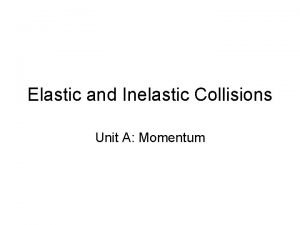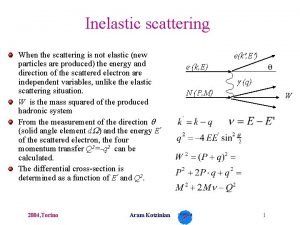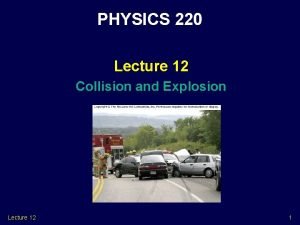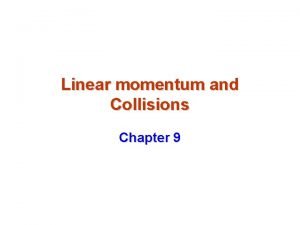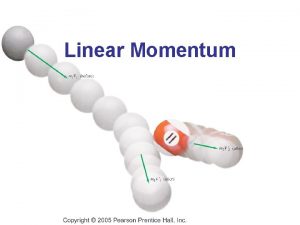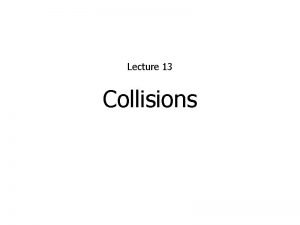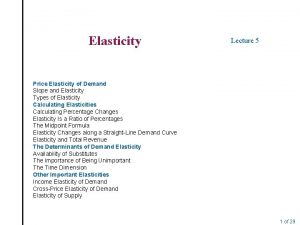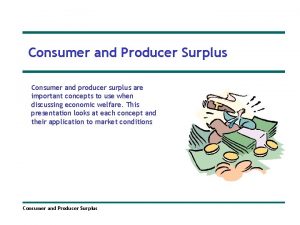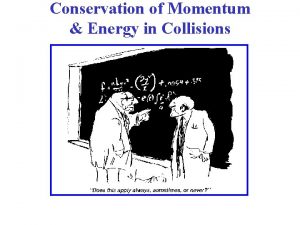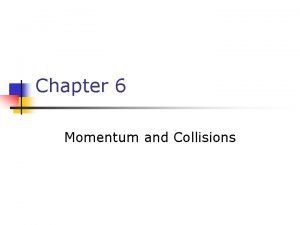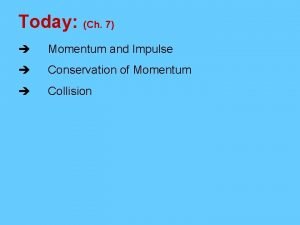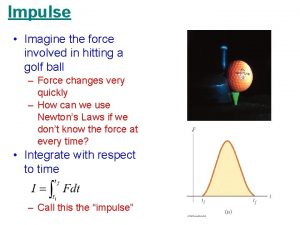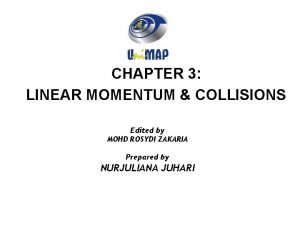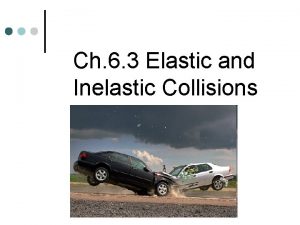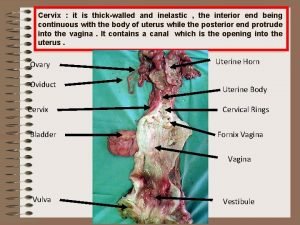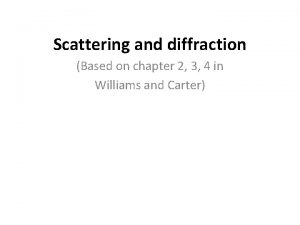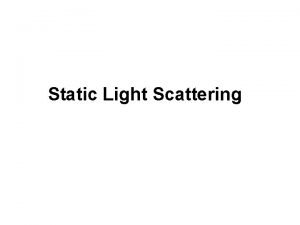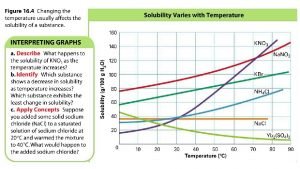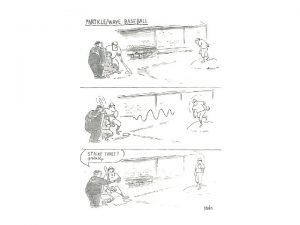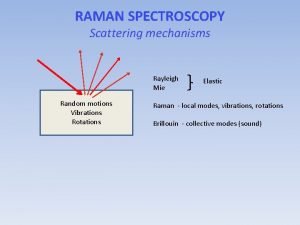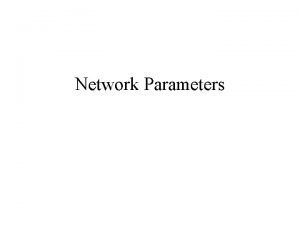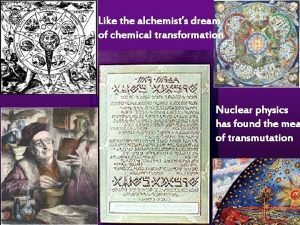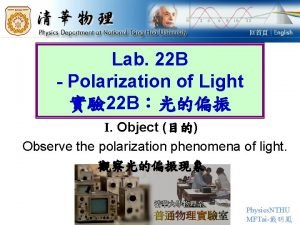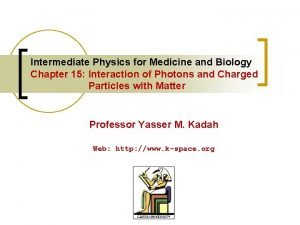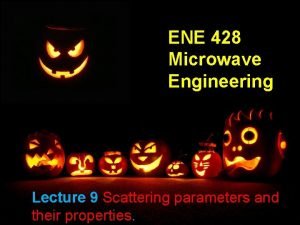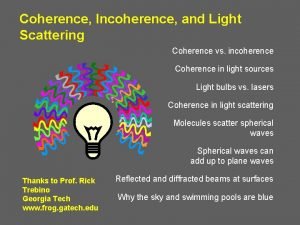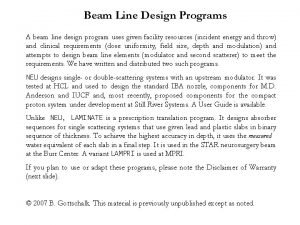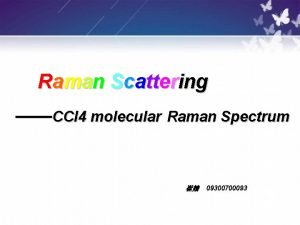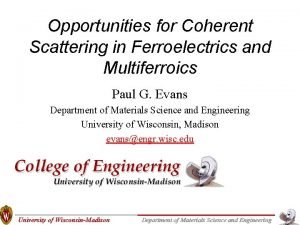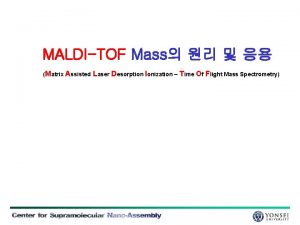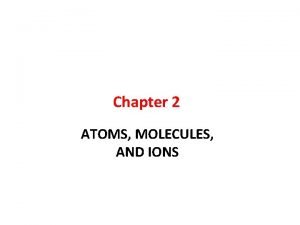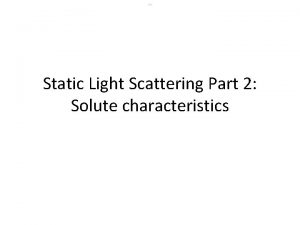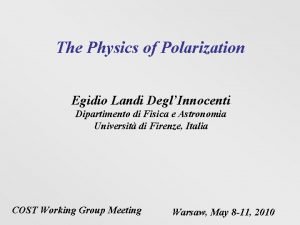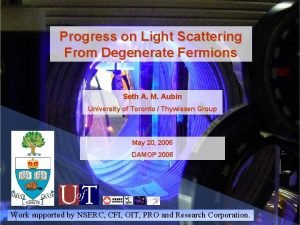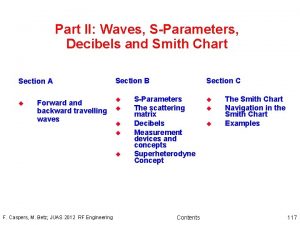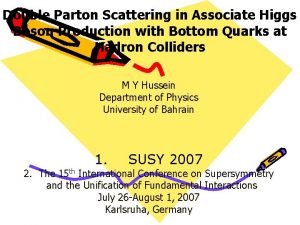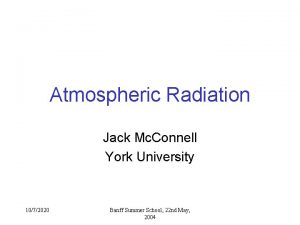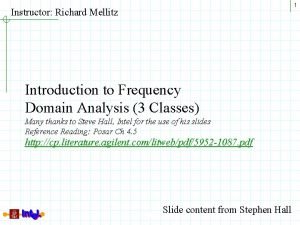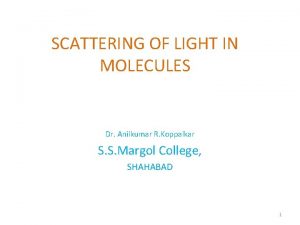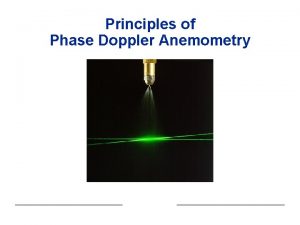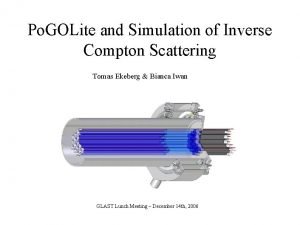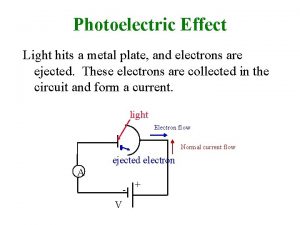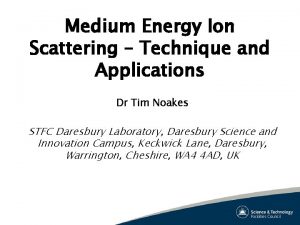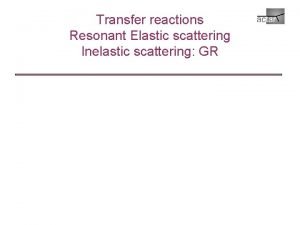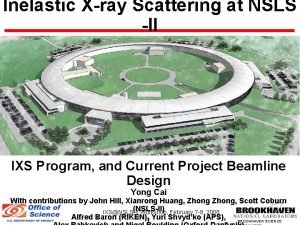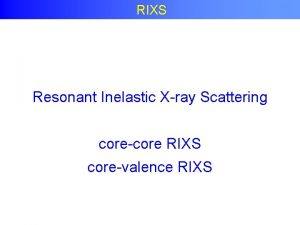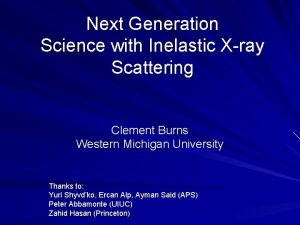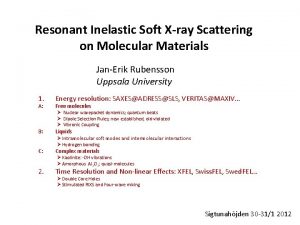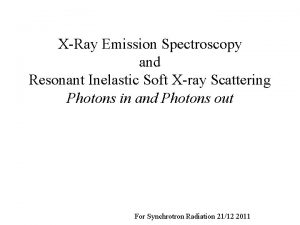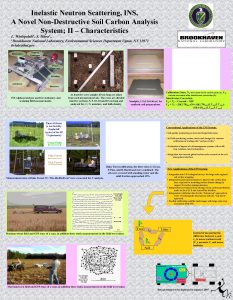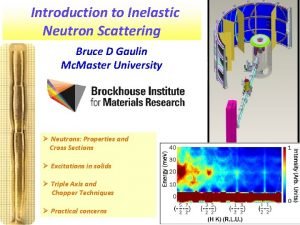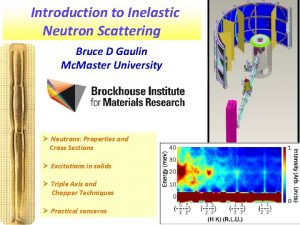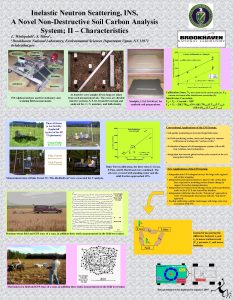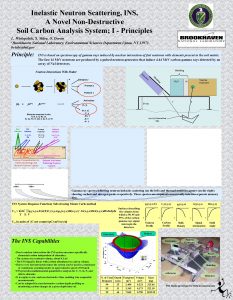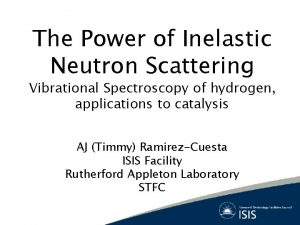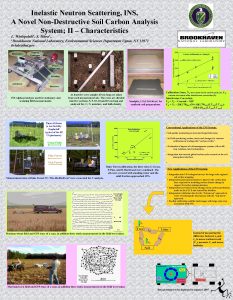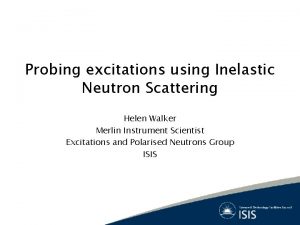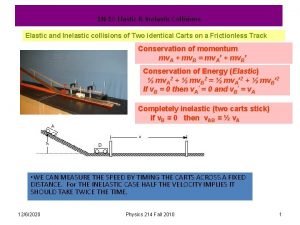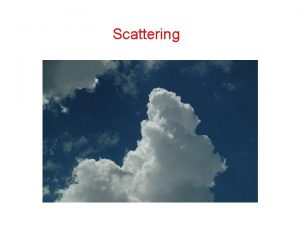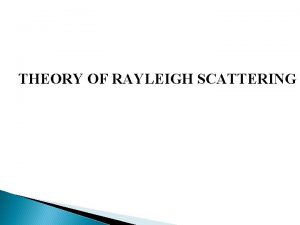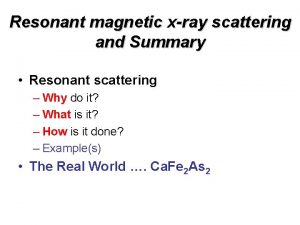Inelastic neutron scattering Applications of Xray and neutron



























































- Slides: 59

Inelastic neutron scattering Applications of X-ray and neutron scattering in biology, chemistry and physics 23/8 2012 Niels Bech Christensen Department of Physics Technical University of Denmark nbch@fysik. dtu. dk

Outline • Repetion from spectroscopy talk • Cross-sections for phonons and magnons, compared and explained • Instruments (more detailed) with examples of results • The resolution function

Conservation laws Scattering triangle ki kf Q Momentum Energy Spin (Polarization analysis) Inelastic scattering: ħω≠ 0

Types of scattering Elastic Inelastic Quasi-elastic

Why inelastic scattering? Because coherent propagating modes and damped modes control many physical properties of real materials Magnetism Lattice vibrations • • Thermoelectrics • Superconductors • . . . Ferroelectricity Multiferroics Superconductors Magnetocaloric materials Quantum magnets …

Which region do we cover? • Atomic scales and energies in the range 1 -1000 me. V • A certain complementarity with RIXS is developing

Basics Neutrons • Charge 0 • Spin ½ • m=1. 675 10 -27 kg Radiation wavelength λ=2π/k 1 Å (solid state physics) 4Å 40 Å (large scale structures, bio) X-rays • Charge 0 • Spin 1 • m=0 Neutron energy 80 me. V Phonons, 5. 00 me. V magnons, … 0. 05 me. V

Interactions 1. Nuclear interaction with atomic nuclei • Short range : ~10 -14 – 10 -15 m • Isotropic, central potential Vn=Vn(r) • Typical magnitude of cross-section: 10 -28 m 2 2. Magnetic interaction with the angular momenta of electrons in unfilled shells • Longer range : ~10 -10 m • Anisotropic, non-central potential Vm=Vm(r) • Typical magnitude of cross-section: 10 -28 m 2

1994: Nobel price winners "for pioneering contributions to the development of neutron scattering techniques for studies of condensed matter" Clifford G. Shull (1915 -2001), USA "for the development of the neutron diffraction technique" ”Where atoms/spins are … Bertram N. Brockhouse (1918 -2003), Canada "for the development of neutron spectroscopy" ”… and what atoms/spins do”

Elastic scattering: Diffraction “…where atoms/spins are…” • Crystal structures, polymers, … • Magnetic structures, flux-line lattices, … • Charge and orbital ordering phenomena (Indirectly, through the associated small distortions of the lattice) … as a function of pressure, electric/magnetic field and temperature. ki=kf kf Q ki ħω=0

Inelastic scattering Spectroscopy “…what atoms/spins do…” • Phonons in crystalline materials • Magnetic excitations Energy scale ~ me. V … as a function of pressure, electric/magnetic field and temperature. ki>kf ki ħω>0 ki<kf kf Q kf ħω<0 Q ki

Inelastic scattering Spectroscopy “…what atoms/spins do…” • Phonons in crystalline materials • Magnetic excitations Energy scale ~ me. V … as a function of pressure, electric/magnetic field and temperature. Diffraction always comes spectroscopy! ki>kf ki<kbefore f k f Attempts to understand the vibrations Q kf Q of a given material has ki no logical base without the knowledge of its structure. There would be no way to model the data. ħω>0 ħω<0 ki

Outline • Repetion from spectroscopy talk • Cross-sections for phonons and magnons, compared and explained • Instruments (more detailed) with examples of results • The resolution function

Cross-sections Partial differential scattering cross-section ≡ # neutrons hitting the detector per second, with energies between Ef and Ef+d. Ef

Cross-section The cross-section is related to a quantum mechanical matrix element squared, i. e. a transition probability • Prefactor kf/ki • Squared matrix element of the interaction potential V • Energy conservation ensured by delta-function which contains the neutron energy transfer ħω

Nuclear excitations: Phonons Lattice vibrations (Phonons) M K K’s and phonon spectra can be calculated in principle, and can be measured • Bose occupation factor n(ωs) • Sums over nuclear Bragg peaks and mode indices s • Phonon polarization es • Debye-Waller factor (zero-point vibrations)

Nuclear excitations: Phonons Lattice vibrations M K K’s and phonon spectra can be calculated in principle, but can really be measured Phonon creation Increases with Q Phonon annihilation Why? Anharmonicity, soft modes, relation to functionality (e. g. superconductivity), …

Magnetic excitations: Spin waves 2 /a O K 2 /a H Cu(DCOO)2· 4 D 2 O J<0 Ferromagnet J>0 Antiferromagnet FM: Magnetic Bragg peaks on top of the nuclear AFM: New Magnetic Bragg peaks due to doubling of the magnetic unit cell

Magnetic excitations: Spin waves Rb. Mn. F 3 Sharp excitations Note analogies with lattice vibrations/phonons

Phonons vs. magnetic excitations Phonons Increases with Q Increases with T Decreases with Q Bose statistics for simple ordered systems (FM, AFM, etc. ). Spreads in Q and ћω at high T The final kill: Neutron polarisation analysis

Outline • Repetion from spectroscopy talk • Cross-sections for phonons and magnons, compared and explained • Instruments (more detailed) with examples of results • The resolution function

Conservation laws Scattering triangle ki kf Q Momentum Energy Spin (Polarization analysis)

Kinematic constraints kf 2θ ki (kf fixed) Q (ki fixed) ki fixed kf fixed

Neutron Spectroscopy Spallation Source Instruments Remember how a spallation source works: • A pulsed proton beam hits a target made from a heavy element target • The fast neutrons are moderated, but the result is still a pulsed beam Time-of-flight principle Distance L Moderator Detector

Neutron Spectroscopy Spallation Source Instruments Remember how a spallation source works: • A pulsed proton beam hits a target made from a heavy element target • The fast neutrons are moderated, but the result is still a pulsed beam Time-of-flight principle Impossible to determine the energy transferred Distance L 1 Moderator Sample Distance L 2 ? ? ? Detector

Neutron Spectroscopy Spallation Source Instruments Remember how a spallation source works: • A pulsed proton beam hits a target made from a heavy element target • The fast neutrons are moderated, but the result is still a pulsed beam Time-of-flight principle Direct time-of-flight geometry: Constant ki instruments Distance L 1 Sample Moderator Distance L 2 Detector Chopper Monochromator

Direct time-of-flight spectrometers ki fixed MAPS, ISIS Choppers • Low incident flux • Low flexibility (TOF parabola) • Massive parallel data acquisition in (Q, ħω) “Making maps of magnetism”

Practical direct TOF Detector Sample Fermi chopper Background chopper Source

Practical TOF Conservation laws Time-of-flight parabola in (Q, ћω) Q|| ki • I(Q, ћω) is probed along the TOF parabola. Q┴ • Unlike TAS, constant wavevector scans are not possible (if the data are taken in one setting). At fixed (Qx, Qy), Qz varies with ћω, leading e. g. to a variation of the form factor. • Counting time ~ hours/days per “run”. • One analyses constant energy or wavevector “cuts” in a data set of corresponding values of (Qx, Qy, Qz, ћω) and intensities. • Incident energy Ei, chopper speeds (resolution) and sample orientation relative to ki can be changed.

Cu(DCOO)2· 4 D 2 O Christensen et al La 5/3 Sr 1/3 Ni. O 4 Woo et al. , PRB 72, 064437 (2006) La 1. 875 Ba 0. 125 Cu. O 4 Tranquada et al. , Nature 429, 534 (2004) Y 2 -x. Cax. Ba. Ni. O 5 Xu et al. , Science 289, 419 (2000)

Neutron Spectroscopy Research Reactor Instruments Spectrometry can be done in three ways • Give the beam a time structure and use timeof-flight tricks • Spin echo • Triple axis spectrometers

Practical TAS Extremely simple principle due to Brockhouse 3 axes • Monochromator-Sample (a 1, a 2=2θM) • Sample-Analyser (a 3, a 4 =2θs) • Analyser-Detector (a 5, a 6= 2θA) • a 1, a 3, a 5 are rotations of the mono, sample and analyser about the vertical • The setting of a 2 and a 1=a 2/2 defines ki • The setting of a 6 and a 5=a 6/2 defines kf • The setting of a 3 and a 4 defines the Q of the crystal probed

Triple-axis spectrometers Bragg’s law Analyzer (Bragg reflection) λ Sample S(Q, ω) Monochromator (Bragg reflection) λ θ θ d • High incoming flux: O(107) n/s/cm 2 (IN 14) • Flexible • Point-by-point measurements in (Q, ħω) space • Cold: 2 me. V <Ei<15 me. V • Polarization analysis • Thermal: 15 me. V< Ei<100 me. V • Hot: Ei>100 me. V

Elements: Monochromator A good monochromator material should: • Should have a high σcoh/ σinc ratio • Should have a high peak reflectivity • Should not be too perfect (due to extinction, backside does not scatter) Modern monochromators focus in 1 or 2 directions large gains in flux at the sample position, at the expense of increased beam divergence

Elements: Collimators From ETH Zürich, neutron scattering course, A. Zheludev.

Practical TAS • Angular beam divergence can be reduced using collimators Ci • Modes: ki or kf are kept constant. The scattering senses (left/right) at sample and analyzer positions can be changed. • Higher order reflections are allowed by Bragg’s law (n>1). Neutron filters are often inserted before and/or after the sample, to discriminate against neutrons with energies 4 E, 9 E, … C Longchair Plough W • Q is essentially restricted to the plane defined by two userchosen horizontal reciprocal lattice vectors. • ћω is varied by rotating the monochromator/analyzer. The inplane components of Q are varied by changing 2θ (=2θS) and rotating the sample around a vertical axis. • One performs constant energy scans (Intensity versus in-plane components of Q at fixed ћω) or constant wavevector scans (Intensity versus ћω at fixed Q). • Counting time ~minutes pr. point.

Example: Constant Q Scan with kf fixed ki kf Q q 0, 0, 0 Ghkl h, k, l Procedure: • kf (Ef) and Q are fixed • For a given can find (Ei) ki and • Hence can plot scattering triangle • Similar technique gives constant scans Width of observed peak is determined by resolution Energy

Brockhouse: phonons in Ge B. Brockhouse (1957) Q || (111)

Spin waves in saturated phase of Cs 2 Cu. Cl 4 Coldea et al, PRL 88, 137203 (2002) Phonons dispersion curves and eigenvectors in Si Kulda et al, PRB 50, 13347 (1994) Spin gap below Tc in optimally doped La 2 -x. Srx. Cu. O 4 Lake et al, Nature 400, 43 (1999) Bose-Einstein condensation of triplet states in Tl. Cu. Cl 3 Ruegg et al, Nature 423, 62 (2003)

Outline • Repetion from spectroscopy talk • Cross-sections for phonons and magnons, compared and explained • Instruments (more detailed) with examples of results • The resolution function

The resolution function Idealized: Realistic: ki kf Q • Distributions {ki} and {kf} around nominal ki and kf lead to distributions of Q and ћω ki kf Q Consequence: The measured intensity is not simply proportional to S(Q, ω), but is equal to the convolution of the dynamic structure factor S(Q, ω) with the resolution R(Q-Q 0, ω-ω0) • R(Q-Q 0, ω-ω0) depends on all factors influencing {ki} and {kf} e. g. choice of energies, beam collimations, instrument dimensions, scattering sense, crystal mosaicities (TAS) and detector dimensions, chopper speeds (TOF)

4 x 4 matrix • Contours of constant R are ellipsoids in 4 -dimensional (Q, ћω) space • Qz resolution is decoupled and typically much broader than other components • R(Q-Q 0, ω-ω0) can be measured. At Bragg reflections

• Focussing: When the slope of R matches that of the dispersion, a sharp mode is observed. Conversely, for a large slope mismatch, a broad mode is observed. In extreme cases, the broad mode may become invisible. Transverse acoustic phonons in Mg. O.

• Resolution tailoring: Take advantage of the high flexibility of a TAS to optimise the resolution conditions for a given measurement, obtaining sharper spectra and better signal-to-noise levels. Incident beam resolution volume Vi~ Ai(C 0, C 1, …)ki 3 cot(θM) Scattered beam resolution volume Vf~ Af(C 2, C 3, …)kf 3 cot(θA)

• R(Q-Q 0, ω-ω0) is computable using analytic formulas (Gaussian approximations of all contributing factors) or using Monte Carlo simulations of the neutron flight path through the instrument. See this afternoon • Data analysis: Choose a model for S(Q, ω). Convolve with R(Q-Q 0, ω-ω0) and fit to the experimental data. • Accurate knowledge of R(Q-Q 0, ω-ω0) is essential in order to extract trustworthy values of widths in Q and ћω, which can in turn be related to real-space correlations lengths and excitation lifetimes

Conclusions • Inelastic neutron scattering is the study of propagating and damped modes involving two-particle correlations (as opposed to diffusion) • Inelastic scattering lets us understand the dynamic properties of materials and extract lattice and magnetic couplings. • This, in turn, allows us to understand structure/magnetism and ultimately the functionality of materials. • Main spectroscopic tools: Direct time-of-flight, triple axis spectrometers. Each has its advantages and disadvantages in terms of flux, resolution, ease of data-analysis, …


Example: Effect of superconductivity on phonon lifetime

Electrical resistivity in metals What determines the resistivity?

Electrical resistivity in metals • Electron-defect scattering • Edges, missing atoms, different atoms …

Electrical resistivity in metals • Electron-electron scattering

Electrical resistivity in metals

Electrical resistivity in metals • Electron-phonon scattering • Lattice vibrations

Electrical resistivity in metals e-defects e-e e-ph

Electrical resistivity in superconductors

Superconductors Bardeen, Cooper, Schrieffer (1957) Superconductivity is mediated by lattice vibrations, which can cause electrons (fermions) to pair, despite the strong Coulomb repulsion. These Cooper pairs are bosons and can Bose-Einstein condense into the same ground state. In this state the electron spectrum has a gap Δ(T) related to the cost of breaking a pair

Demonstration using phonon lifetime Nb 3 Sn, Tc=18. 3 K J. D. Axe, G. Shirane, Phys. Rev. Lett. 1973

Neutron Spectroscopy Spallation Source Instruments Remember how a spallation source works: • A pulsed proton beam hits a target made from a heavy element target • The fast neutrons are moderated, but the result is still a pulsed beam Time-of-flight principle Indirect time-of-flight geometry: Constant kf instruments Distance L 1 Sample Distance L 2 Moderator Detector Analyser

Indirect time-of-flight spectrometers IRIS@ISIS • White incident beam • Bragg reflection at analysers; 2θA~180° From Ef~λf-2 and Bragg’s law, nλf=2 dsin(θA) Cs 2 Cu. Cl 4 Coldea et al, PRB 68, 134424 (2003) See Heloisa Bordallos talk for more on high resolution measurements
 Elastic vs inelastic vs perfectly inelastic
Elastic vs inelastic vs perfectly inelastic What makes some collisions elastic and others inelastic
What makes some collisions elastic and others inelastic Elastic scattering vs inelastic
Elastic scattering vs inelastic Elastic and inelastic collision
Elastic and inelastic collision Types of collisions worksheet
Types of collisions worksheet Elastic collisions kinetic energy
Elastic collisions kinetic energy Elastic collision
Elastic collision Inelastic collision examples
Inelastic collision examples How to find kinetic energy lost in inelastic collision
How to find kinetic energy lost in inelastic collision Elasticity measures
Elasticity measures Price elasticity of demand numericals
Price elasticity of demand numericals Supply elasticity
Supply elasticity Perfectly inelastic demand
Perfectly inelastic demand Consumer and producer surplus
Consumer and producer surplus How do we know momentum is conserved
How do we know momentum is conserved Momentum between two objects
Momentum between two objects Glancing collision
Glancing collision Perfectly inelastic demand
Perfectly inelastic demand Inelastic collision examples
Inelastic collision examples Inelastic collision examples
Inelastic collision examples Perfectly inelastic collision definition
Perfectly inelastic collision definition Inelastic collision examples real world
Inelastic collision examples real world Inelastic cervix
Inelastic cervix Area of cross section
Area of cross section Diffraction and scattering
Diffraction and scattering Rayleigh scattering formula
Rayleigh scattering formula Scattering of light in suspension
Scattering of light in suspension Scattering in a central force field
Scattering in a central force field Rayleigh vs mie
Rayleigh vs mie Mie scattering vs rayleigh
Mie scattering vs rayleigh Coherent scattering
Coherent scattering Scattering cross section in nuclear physics
Scattering cross section in nuclear physics Convert s parameters to impedance
Convert s parameters to impedance Dynamic scattering type lcd
Dynamic scattering type lcd Scattering reaction
Scattering reaction Compton scattering vs photoelectric effect
Compton scattering vs photoelectric effect Polarisation by scattering
Polarisation by scattering Compton scattering formula derivation
Compton scattering formula derivation Scattering matrix of a reciprocal network is
Scattering matrix of a reciprocal network is Scattering of light
Scattering of light Double scattering
Double scattering Scattering reflection
Scattering reflection Raman scattering definition
Raman scattering definition Coherent scattering
Coherent scattering Dynamic light scattering 원리
Dynamic light scattering 원리 Rayleigh theory of light scattering
Rayleigh theory of light scattering Rutherford scattering
Rutherford scattering Rayleigh theory of light scattering
Rayleigh theory of light scattering Scattering matrix
Scattering matrix Pauli blocking of light scattering in degenerate fermions
Pauli blocking of light scattering in degenerate fermions Scattering matrix
Scattering matrix Double parton scattering
Double parton scattering Scattering efficiency
Scattering efficiency Scattering matrix
Scattering matrix Scattering of light
Scattering of light Sezione d'urto thomson
Sezione d'urto thomson Light scattering
Light scattering Golite trig 2
Golite trig 2 Photoelectric effect formula
Photoelectric effect formula Medium energy ion scattering
Medium energy ion scattering
